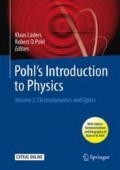Abstract
For image formation, basically only one condition needs to be fulfilled: The rays which originate at “object points” must be limited to a small spatial opening angle ω by passing through an aperture (Sect. 16.1) on their way to the image plane (e.g. a projection screen or a photographic plate). In Fig. 17.1a, the aperture B is a small round opening (pinhole camera!); in Fig. 17.1b, it is a small planar mirror. In both cases, as a suitable object to be imaged, we have chosen an arrow or letter made with small light bulbs.
Which opening angle ω for the radiation gives the sharpest “image points” (or, in modern terms, “pixels”) for a given distance between the object and the image plane? (The image points are small circular disks which make up the image.) The answer will be given later in Sect. 21.8. The decisive quantity which determines it is the wavelength, which is a property of the radiation.
Notes
- 1.
The illumination lens or condenser C has to form an image of the crater K of the arc lamp (the source point of the illumination) in the plane of L 1, and its diameter must be greater than that of the lens L 1.
- 2.
- 3.
Units: 1 degree (\({}^{\circ}\)) = \(1.745\cdot 10^{-2}\) rad, 1 minute of arc (\({}^{\prime}\)) = \(2.91\cdot 10^{-4}\) rad, 1 second of arc (\({}^{\prime\prime}\)) = \(4.86\cdot 10^{-6}\) rad (cf. Vol. 1, Sect. 1.5).
Author information
Authors and Affiliations
Corresponding author
Editor information
Editors and Affiliations
Rights and permissions
Copyright information
© 2018 Springer International Publishing AG
About this chapter
Cite this chapter
Lüders, K., Pohl, R.O. (2018). Image Formation and Light-Beam Boundaries. In: Lüders, K., Pohl, R. (eds) Pohl's Introduction to Physics. Springer, Cham. https://doi.org/10.1007/978-3-319-50269-4_17
Download citation
DOI: https://doi.org/10.1007/978-3-319-50269-4_17
Published:
Publisher Name: Springer, Cham
Print ISBN: 978-3-319-50267-0
Online ISBN: 978-3-319-50269-4
eBook Packages: Physics and AstronomyPhysics and Astronomy (R0)

